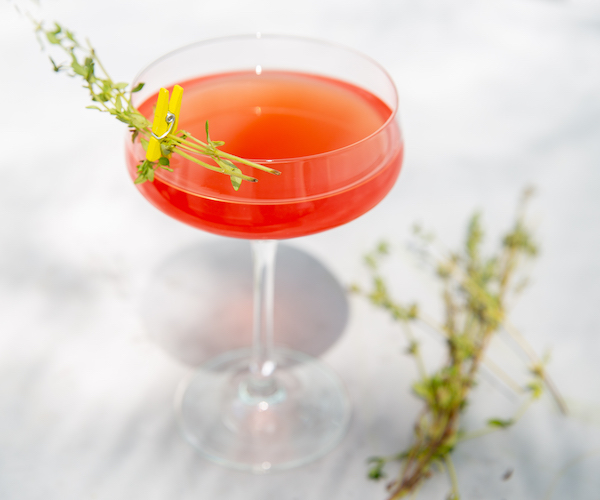By: Nicole Campbell
“Wee Fromage” at Lifford Wine Agency
I grew up in an alternatively religious household. While some children were rushing to churches, temples or synagogues I was being indoctrinated into the cult of Pinot. Our master, the pinot grape, is temperamental. She demands moderation and scoffs at unprivileged terroir. She flippantly garners the obsession of winemakers and lovers, only to shatter their hopes and pocketbooks. Without the confluence of a myriad of esoteric factors she is a tyrant, but when things are just right she is heaven in a glass.
This past Monday I met a fellow member of the tribe. Mark Vlossak founded St. Innocent Winery in Salem, Oregon in 1988 and continues to be their winemaker and President. “Some of these winemakers are “winemakers”, but really hire others to do the dirty work” he chimed, “but I’m right in there, getting my hands dirty. I just love the job”. Okay I was starting to like this guy, and the tasting hadn’t even begun.

The tasting room all ready for our Oregon wine seminar
Mark introduced his informative and impassioned 2-hour seminar on “Oregon through the Ages” by speaking to our limited ability to intellectualize wine. Clearly, a lover of Burgundy he used the famous pinot region to illustrate his point. “Wouldn’t Burgundy’s climate be better if it rained less?,” he emphatically questioned. “It should be, but then you’d be in Alsace. Have you ever had a great Alsatian pinot? Ya, that’s what I thought.” Point taken, sometimes we don’t know why certain regions or vineyard, or even vineyard blocks make the best wine. We can say it’s the soil, or the microclimate, but ultimately there is an element of the unknown that elevates certain plots of land to higher expressions of a varietal.
The history of Oregon winemaking has certainly been one of discovery and peeling back layers of the unknown. Wine was first produced in the area in 1825, but it wasn’t until 1965 when David Lett planted vines in the Willamette Valley that fine wine emerged as a possibility. Within 15 years, wines from the region were standing up to Burgundian pinots in competitions. When Vlossak moved from Colorado to grow grapes in 1980 he was one of 60-someodd wineries in the region, now there are over 400. Even with the explosion of the industry, it remains small and dominated by family-run businesses striving to make premium wine. To put it in perspective, Oregon produces the equivalent of 1% of the wine they make in California.

The tasting spread: Pinot Gris and a pile of Pinot Noir
Some interesting climactic, geographical, and environmental facts:
-91% of Oregon pinot is grown in the top half of the Willamette Valley
-In California you can only grow pinot because of the cooling coastal winds, in Oregon you can only grow Pinot because a sheet of 3,000 foot mountains shelters the area from the coastal winds. Without these mountain ranges creating a wind barrier thus allowing the valleys to heat up during the day, this cool climate region would not be warm enough to properly ripen grapes.
-In the upper section of the valley the mountains are only 1,000 feet high, resulting in stronger winds and a harsher climate. These additional stressors create fantastic spice and more muscular and structured wines. One of these windier regions is Salem, where St. Innocent is found. It is precisely because of the harsher climate and additional complexities of the resulting wines that they chose that area to grow grapes.
-While the valleys of Willamette heat up in the day, they quickly cool when the sun sets, nightly temperature drops between 1 and 10˚C normative. This large diurnal temperature shift is essential for the wines acidity and balance.
-Biodynamic and sustainable practices are highly encouraged and Oregon remains the only wine region in the US with a third-party certified sustainability program.
-While organic has become a buzzword in the wine industry it means very little in terms of environmental impact. “Organic viticulture focuses on what you can’t do in your vineyard, it says nothing of sustainability”, Mark explained. Biodynamic viticulture, on the other hand, focuses not on what you can’t do, but on what you should do to guarantee sustainability and promote life in the in the vineyard. It is with this dedication to sustainability that St. Innocent uses biodynamic farming practices.
Enough talk, what did you drink?!
1. St. Innocent 2007 Pinot Gris

A delicious treat. St. Innocent 2007 Pinot Gris.
Mark began the tasting with a single-vineyard pinot gris. While most pinot gris wines are produced in large volumes to be a summer slinger, this wine was not made to be “cheap and easy”. It is instead spicy, concentrated and texturally complex with notes of citrus and pear. The natural acidity of this dry wine adds to its impressive mouth feel. Mark produces his Pinot Gris in an Alsatian style, focusing on grape ripeness, fastidious pruning and hand picking, only bottling the wine after eight months of lees aging.
2. St. Innocent ‘Shea Vineyard’ Pinot Noir

2008 Shea Vineyard Pinot Noir
Shea Vineyard is located in the Yamhill-Carlton District, 35 miles southwest of Portland. Mark described the vineyard as capable of great complexity and subtle nuances. Overall I found this wine to be the most balanced and ready-to-drink of all the pinots we tasted. There was a smooth richness, good acidity and just the right tannin structure. Wonderful aromas of black and red fruit, dried flowers and dusty earth on the nose. Overall a beautiful wine.
3. St. Innocent ‘Momtazi Vineyard’ Pinot Noir

2007 Momtazi Vineyard Pinot Noir
Momtazi Vineyard is in the McMinnville appellation, located high above a warm valley and affected by strong coastal winds blown through the Van Duzer corridor. Both a sunny hillside providing exceptional ripeness and a windblown ridge of thin-soil, this vineyard is famous for its dense fruit and rich tannins. Indeed the wines wild, dark intensity screamed to be noticed, proudly displaying its terroir. Notes of dark, exotic spice and ripe black fruit on the nose and palate. This is a wine made to age and a totally interesting, unique expression of regional terroir. Would pair beautifully with anything earthy, braised or stewed.
4. St. Innocent ‘Justice Vineyard’ Pinot Noir

2007 Justice Vineyard Pinot Noir
Justice Vineyard is located just over the east ridge of the Eola-Amity Hills. Planted in 2001, the thin volcanic-soiled vineyard sits at 500 feet in elevation facing the Cascade Mountains. Using high density planting of the most complex Dijon clones, clone 777, this wine certainly comes with an impressive pedigree. Pumpkin spices on the nose (cinnamon, clove) with lovely red fruit. Mark described this vineyard site as “the sweet spot”, which consistently makes texturally rich wine with the perfect balance of fruit, acidity, and tannin. If you can get your hands on this small production wine, I suggest you do.







